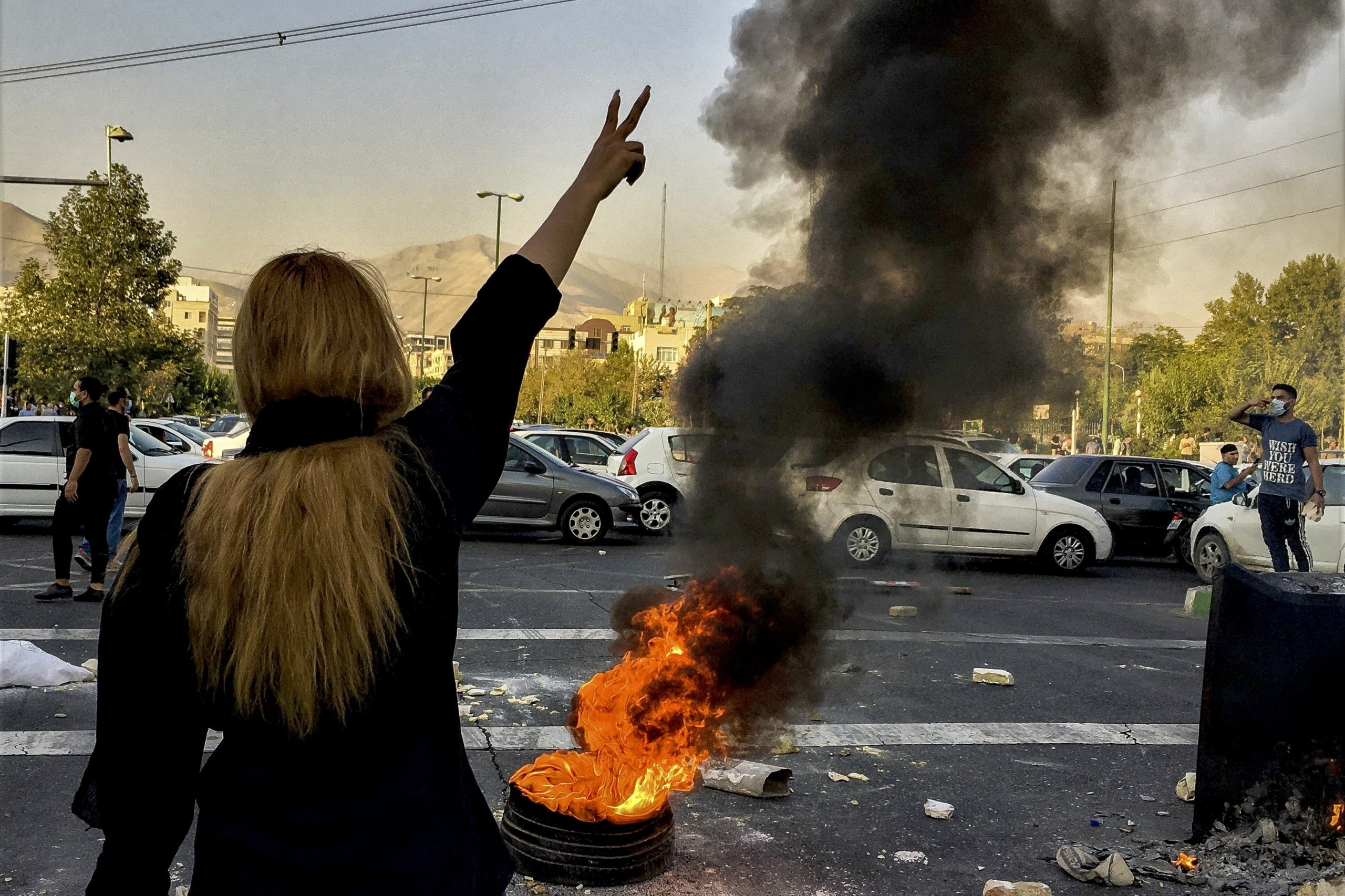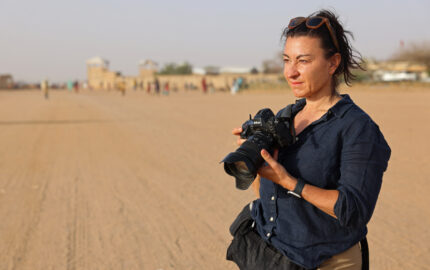On Sept. 22, Iranian journalist Niloofar Hamedi, a reporter for the Tehran-based newspaper Shargh, was arrested in her home by authorities. Her house was raided, her laptop and phone confiscated, and her Twitter account suspended. Hamedi’s husband and lawyer shared on social media that she was being interrogated and held in solitary confinement.
Hamedi was among the first journalists to report on the story of Mahsa Amini, a 22-year-old Kurdish woman who died in the custody of Iran’s morality police after being arrested, allegedly for not complying with the country’s strict hijab laws. Amini’s death sparked a wave of mass protests across Iran, and authorities have responded by arresting protesters and journalists, many of them women. The Committee to Protect Journalists (CPJ), a media rights organization tracking the detentions of journalists covering Amini’s death and the ensuing protests, has documented at least 40 arrests.
Yeganeh Rezaian, a CPJ senior researcher who was detained by Iranian authorities and held for 72 days, 69 of them in solitary confinement, in 2014 while she was a reporter for the UAE-based newspaper The National, spoke with Nieman Reports about the implications of the recent developments in Iran. Below are edited and condensed excerpts of that conversation:
Reporters Without Borders routinely ranks Iran as one of the 10 worst countries for press freedom. Can you give a bit of context about what the media ecosystem was like even before the protests?
What is happening to Iranian journalists is not a very unexpected thing. Iran constantly lands on our list as one of the most censored countries in the world and among the top jailers of journalists. Every year CPJ documents the number of Iranian journalists who are behind bars, and last year there were 11. Early this September, before these protests broke out, we documented 15 journalists already in prison [not counting the 40 arrests made during recent protests]. That makes Iran one of the biggest, if not the biggest, [jailer of journalists] this year so far.
The work of journalists still inside Iran is a very precious commodity, facing extinction because traditional journalists have a very hard time reporting on topics such as politics, press freedom, social freedom, human rights — because all media in Iran is state run.
Many journalists use their social media platforms, such as Instagram and Twitter, to report because they cannot freely report on state-run newspapers, TV, or radio. The government monitors social media platforms very heavily, and any reporting on those platforms is shut down, and there are very terrible consequences for journalists. Many of the 40 journalists we have documented were arrested as soon as they used their Twitter account to report on the number of people killed or arrested during the protests.
Do you see the current crackdown against the media as a continuation of that? Or is there something else happening now?
It is not new that every time there is a major national protest or a general sense of dissatisfaction in the country, journalists face repercussions for their work more than ever. It's in line with the fact that the Iranian government arbitrarily silences any critical voice or anyone who wants to report on what is happening in the country. It starts with detainment, imprisonment, interrogations, sleeping on the concrete in a small cell, lots of long hours of very mentally wrenching and draining interrogations.
Some might be able to get released after those interrogations before a pre-trial if the cases are very important to the regime, which I assume, for example, the Niloofar Hamedi case is. They see her as a dangerous threat. They usually keep those journalists in much longer detentions and interrogations and put them on trial without any due process. Then they get very heavy sentences of at least several years in prison and banned from journalism activities.
The regime is using the same tactics. For example, they raid the journalists' homes in the middle of the night to create an environment of fear. They try to scare the family members. They try to scare the bystanders and neighbors.
What is new is the amount of violence that they are using while they are arresting journalists. They have always treated journalists and critical voices harshly, but this time around it seems as if they do not shy away from beating the journalist in public, while they arrest them in the streets, or when they raid their homes in several cases. It was reported to the CPJ that journalists were arrested after they were beaten up. Someone's head was broken and was bleeding. Someone's leg was broken. A journalist was beaten in front of his daughter. Another was beaten up in the street. The amount of violence is astonishing to me in a very terrible way. And the government is trying to send a message by doing so.
What precipitated that change?
As all media in Iran is state-run, every time they scared journalists from reporting about a significant incident in the country, they were pretty sure that tomorrow morning, no one will see headlines about that news in any media, right? But now, because of the power of social media, Iranian journalists are willing to publish stories or reports on their personal platforms.
I think some of this brutality and violence [stems] from the fact that the regime sees the situation as a little bit out of their control, because they cannot compete with the power of social media and what gets published there. And once the news broke on Twitter, for example, that they killed this many people, it's not wipeable, right? That is going to be there forever.
What don’t outside observers understand about what’s happening in Iran now with respect to press freedoms?
There are very few foreign media based in Iran, less than a handful of them. And some of those [who are there], like AP or AFP, unfortunately, have local bureau chiefs, local reporters. The problem with having local reporters is that the regime can easily scare them or arrest them or silence them. The mission of reporting about what is happening inside the country [falls] on the local, Iranian reporters, and they cannot really report on anything. That makes it extra hard to get a real scope or trajectory of the protests happening in the country.
The fact that foreign media do not have a presence there also makes it more difficult for Western media outside of the country to report on these protests. I have seen criticisms over why, for example, The New York Times or The Washington Post or CNN do not report these protests more. The truth is that there is no CNN, there is no New York Times, there is no Washington Post in Iran. How could we expect them to cover it more?
This is what I want people to know. Both Iranian Americans in the diaspora and Americans should know the fact that if you do not see more news about the protests in the news, it's not that the protests died down, it's not that no one is getting hurt. It's that there's no media covering it for the outside world, and that's what the regime has done throughout the years, purposefully. The regime downsizes the number of foreign media in the country so when it gets to these critical moments, there is no credible foreign media to report on them.
CPJ keeps track of journalists in Iran who have been arrested or detained during the protests. Have you been in contact with any of them? What are the conditions like for them in prison?
As much as possible, because they are in a very dangerous situation, and we don't want to unnecessarily cause them any more risks by contacting them. For most of these journalists who have been arrested, the female ones are taken to Qarchak prison, the only female prison that the regime has.
Yalda Moaiery, a prominent photojournalist [arrested while covering protests], made a phone call out of prison and sent her voice out about the situation [in which] they are keeping them. They're keeping hundreds of female prisoners in one big hall. There are only three bathrooms available for hundreds of prisoners. Food quality is very bad. Often journalists are either handcuffed or blindfolded. They have to sleep on the concrete on the floor with little to no blanket.
In some cases, journalists are taken to Evin prison, which is one of the most notorious prisons in the world that is in the northwestern part of Tehran. That's where I and my husband Jason [Rezaian] were detained. They keep journalists for really long days in solitary confinement. There's no bed. There's no medical attention.
In many cases, I know for a fact that they don't let journalists even shower for days, sometimes weeks. There are long hours of interrogations, there's very little food offered as part of their torture tactic. In most cells, they keep the lights on 24/7 to make sure that they sleep deprive you. If you're lucky, they let you make phone calls to your family for a couple of minutes every now and then to give them a little bit of an update about your situation.
Hamedi was able to make a two-minute phone call to her husband a couple of weeks ago, telling him that she's going through really long and tough hours of interrogations, but she's still not aware of her charges. They have not explained her charges to her. They won't let you hire lawyers. You have to go through all of [this] with no legal help.
Are we starting to see cracks in the government strategy? Do you see more reporters standing up to the government?
I don't see any more journalists publicly standing up to the regime. Obviously, they're still doing their job, but again, we go back to that point that the platforms that they work for, all the newspapers, TV channels, and radio on IRIB, the Islamic Republic of Iran Broadcasting, are government run. But one interesting point is that a few TV anchors have stepped down from their jobs, which is quite telling. And the reason for it is that they came to this realization that, “If I cannot come to my program on a morning show and talk about what has happened last night in the streets of my city, then at least I can step down and by doing so I can show what the truth is.” It's like, showing without saying, right? So, I admire that move. That's one new way TV and radio journalists are standing up to the regime.
What kind of support is there for journalists in Iran who have been arrested or detained?
Legal support is the most we can offer, like putting them in touch with the right organizations, putting them in touch with pro bono lawyers that are on the ground, once the journalist is allowed by the regime to hire a lawyer, send financial help for the families to pay for prison support and legal fees. But most of our work is focused on after release, because that's when the journalist needs mental health support, financial support, and relocation support.
During their imprisonment, being their voice is one crucial way of supporting them if the journalists and the families are willing to let us do so. There are cases that they don't want to have the names of their loved ones out. They do not want us to advocate on their behalf. But advocating on their behalf and making sure the world hears and knows their name is what matters and makes a huge difference.
What difficulties do women journalists, in particular, face covering the ongoing dissent in Iran?
Women journalists have always faced lots of problems in Iran. Iran is a difficult place to report on also because of the misogyny and the patriarchy that is embedded in the system. [The misogyny and patriarchy] used to be in the society, but now I'm seeing that is shifting. Iranian men are very supportive of their fellow sisters, whether journalist or non-journalist, during these protests, and that is very admirable.
But I think the threat this time around is probably more severe and more grave for [female journalists]. Because more women are in the streets protesting than men, it creates an [impression] that any woman who is out in the street should be a protester. I have seen two cases where female journalists who were out covering the protests were arrested with the rest of the protesters, as the security forces just assume that they are also protesters. They were not protesting; they were there with their press gadgets and camera trying to record the situation.
Does anything about the protests or the way the Iranian media is covering them give you hope that change could come to Iran?
Through some of these protests, I believe something has changed within the Iranian society. One, the compulsory hijab, a very fundamental and symbolic part of the system's identity, is being confronted and, in many ways, ignored and questioned by Iranian women. That means there is a real change growing in the Iranian society.
How long does it take? How many protesters does it take? How many journalists behind bars does it take? That's what is hard to say from afar, in the absence of an impartial judiciary, or an impartial human rights organization that can investigate the killings or brutality of the regime. I think there is big hope. It might take a lot, but people are carrying this anger inside their chests and it's like a fire that needs a little bit of a trigger, and then it comes back out again.



